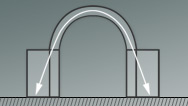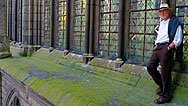Medieval Stained Glass Science
- By Susan K. Lewis
- Posted 08.19.10
- NOVA
Glassmaking dates back at least as far as the 16th century B.C.
In this early epoch, the ancient Assyrians recorded the basic
recipe for glass on clay tablets. But craftsmen of the Middle
Ages raised the practice to a high art in the era of Gothic
cathedral building (A.D. 1150-1500) and developed techniques
still used by glassmakers today. In this slide show, see
stunning examples of stained glass artistry, and learn about the
chemistry behind it.
 Launch Interactive
Launch Interactive
How did craftsmen of the Middle Ages make stained glass
windows using little more than sand, wood, and fire?
Credits
- Special Thanks:
- Robert Brill, The Corning Museum of Glass
Images:
-
(interior of Saint Denis, stained glass at Amiens
Cathedral, window at Chartres, window of the crucifixion
at Chartres, rose window at Saint Denis)
- Courtesy Mark Bussell/Providence Pictures
- (drawing of glassblowing workshop)
-
from The Corning Museum of Glass, "The Science of
Glassmaking: Eight Centuries of a Magical Art"
- (sand grains)
- © Andrea Gingerich/iStockphoto
- (blowpipe in furnace)
- © murat $en/iStockphoto
-
(stained glass of the Prophet Daniel from Ausburg
Cathedral)
- Public Domain
- (glass blower)
- © NOVA/WGBH Educational Foundation
- (stained glass cartoon)
- Public Domain
Related Links
-

How did medieval engineers construct magnificent skyscrapers
of glass and stone?
-

See if you can build a cathedral arch without it collapsing,
and learn more about the forces at work.
-

David Pogue hosts a four-part special series exploring the
materials that will shape our future.
-

The story of two brilliant mathematicians, a unicorn, and a
homemade supercomputer
-

When designing Gothic cathedrals, some medieval builders drew
on sacred measurements laid out in the pages of the Bible.
Close
You need the Flash Player plug-in to view this content.







